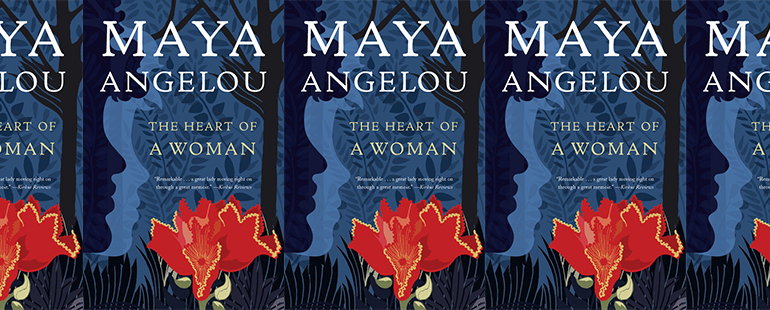The Varieties of Black Liberation in The Heart of a Woman

In a 1990 interview, Maya Angelou admitted to writing characters into her nonfiction who didn’t exist. “Sometimes I make a character from a composite of three or four people, because the essence in any one person is not sufficiently strong to be written about,” she said. “The work is true though sometimes I fiddle with the facts.” To me, this felt like a betrayal. I had put my trust in her, believing, as I read her memoirs, that she was telling me the whole truth.
I later learned that Angelou had been writing in a slave-narrative tradition pioneered by Frederick Douglass, where the word “I” is generally used to mean “we.” And so I warmed to Angelou’s particular brand of fictional nonfiction. She was innovating on the autobiographical mode “to make it bigger, richer, finer, and more inclusive in the twentieth century,” she said.
In The Heart of a Woman (1981), the fourth installment of her memoirs, Angelou herself is a composite character, voicing in a single breath the innumerable lived experiences of the Black diaspora. She travels to New York, London, Cairo, and Accra alongside her freedom-fighter husband, Vus, and her son, Guy. Everywhere she goes, she meets people who look like her but do not necessarily think like her. Black skin, she realizes, does not immediately equate to kinship, and in fact can mask conflicting understandings of the struggle.
The memoir documents Angelou’s deepening involvement in the civil rights movement. She attends a speech by Malcolm X in Harlem: “Every person under the sound of my voice is a soldier,” he booms into the microphone. “You are either fighting for your freedom or betraying the fight for freedom or enlisted in the army to deny someone else’s freedom.” That every Black person, simply by being born, is assigned a role in the liberation movement strikes me as a radical notion. And an over-simplification. I would argue that our understandings of the struggle are as numerous and diverse as the diasporic Black Africans themselves.
~
I have always been a composite character, made up of different identities, different “selves.” At my core, I am a 24-year-old Jamaican-Canadian woman. On closer examination, even this basic identity is knotted with complexity. Hyphenation is not a state, but an act. It introduces social norms, traditions, and ways of being that are in constant conversation (and argument) with one another. Like Angelou, my notions of liberation were at times reinforced and other times undermined during my travels.
Back home on The Rock—Jamaica—my first exposure to liberation was through the words of national hero Marcus Garvey. “We are going to emancipate ourselves from mental slavery,” Garvey said in a 1937 speech. “Whilst others might free the body, none but ourselves can free the mind.” The line was popularized by Bob Marley’s reggae anthem “Redemption Song.” The path to redemption, Garvey believed, was through education and personal development. We were slaves not to the white ruling class, but to ignorance, self-doubt, pessimism, and fear.
My family immigrated from Jamaica to Canada when I was seven years old. The day we arrived, I looked up at the airport signage and spotted the word “sortie,” wondering what that could mean. Years later, I had grown into Canadian culture like the crawling vines of a plant grafted onto a tree. I had studied French to the point of near-fluency, my vocabulary consisting not only of the word “exit” but many others. I decided to spend my third year of university abroad in France.
~
Aix-en-Provence is an almost-coastal town with fountains and cobblestone streets in sunbaked hues of yellow and brown. From the moment I arrived, the French observed me with confusion, knowing somehow I was not from North Africa but unsure where to place me geographically. There, I was doubly displaced: an immigrant to an unfamiliar country living in yet another unfamiliar country. I sought sisterhood in a group of girls who looked like me. They were from the Comoros archipelago off the coast of East Africa and had moved to France to study. When Angelou finds herself among Black peers in Accra after months of travel, she says, “A knot in my stomach, which had bunched all my remembered life, had unfurled.”
Despite our shared island roots and lineage tracing back to Africa, the Comorian women and I were more different than alike, the products of two distinct colonial histories. Comoros was once a French colony. All of its isles except one—Mayotte—voted for independence in a 1974 referendum. Since 2011, Mayotte has been a French overseas department, and it now has a GDP per capita 10 times that of the neighboring Union of Comoros. As a result, half of Mayotte’s residents are illegal immigrants from neighboring islands.
The Comorian woman and I were part of the same diaspora, yet in France, our only similarity was our otherness. Flung far and wide to opposite hemispheres, we had become unrecognizable not only to each other, but to ourselves.
~
My and Angelou’s paths intersect in Harlem, New York. I moved there in 2019 to study journalism; she moved in 1959 to join the Harlem Writers Guild. New York “was the hub, the absolute middle of the world,” writes Angelou breathlessly. “The only place for an intelligent person to be, and to grow.” I, like Angelou, was surprised and comforted by Harlem’s warm embrace of Black culture: the natural hair, the multicolored African prints. But Angelou, who grew up in Arkansas and California, found that the New Yorkers she met were overly fixated on the struggle. “If the West Indies or religion or fashion entered the conversation, in minutes we were persistently examining the nature of racial oppression, racial progress, and racial integration,” she writes.
Harlem is seen as the capital of Black America. It was the birthplace of the Harlem Renaissance, an African American artistic and cultural revival spanning the 1920s and ’30s. I had known so little about African America and now I found myself in its beating heart. As a Jamaican-Canadian, where did I fit in this complex history? Was I from Jamaica? Canada? Africa? “The truth is, you can never leave home,” said Angelou, in the 1990 interview. “You take it with you; it’s under your fingernails; it’s in the hair follicles; it’s in the way you smile; it’s in the ride of your hips, in the passage of your breasts; it’s all there, no matter where you go.” She adds, “You can take on the affectations and the postures of other places, and even learn to speak their ways. But the truth is, home is between your teeth.” But where was home?
~
One day, I knocked on the door of a Harlem church in search of a story for a journalism assignment. A woman answered. “Despite the harshness of their lives, I have always found that older Black women are paragons of generosity,” writes Angelou. “The right plea, arranged the right way, the apt implication, persuade the hungriest Black woman into sharing her last biscuit.” I asked the woman if I could please tell the story of the church; my deadline was approaching and my ideas had run dry. She welcomed me with open arms. I attended services with a pen and paper in hand.
I learned that Mother African Methodist Episcopal Zion was no regular church, but a radical entity that had once been a stop on the Underground Railroad. Sojourner Truth, Harriet Tubman, and Frederick Douglass had all been members. Senior pastor Malcolm Byrd, a self-proclaimed radical named after Malcolm X himself, told me, “We are the church of Black liberation. There’s no hiding that.” Harlem had presented me with yet another path to redemption: Black radicalism.
Byrd took pride in the fact that his services resembled rallies. At the end of each service, the congregation made an impassioned call for freedom, singing the Black national anthem “Lift Every Voice and Sing.” Singing spirituals “had the power to transport us back into a womblike familiarity,” writes Angelou. “Admittedly, Africa was our place of genesis, long, long ago, but more recent, and more dearly known were the sounds of Black America.” Music was her way of reestablishing “a connection to a bitter, beautiful past.” But for some, the bitter past was not so long ago. The wounds are fresh, and the anger is raw.
~
One of my close friends and journalism school classmates is a Zimbabwean-South African filmmaker born in 1990, around the time of the apartheid peace talk negotiations. “When power is handed to you,” she used to say, “it ceases to be power.” She cited the so-called peaceful transfer of power from the white ruling class to Nelson Mandela in April 1994 following the end of apartheid. Critics deemed him too willing to reconcile and negotiate with supporters of apartheid. “Unless power is seized,” my friend would say, “we will never be free.”
I now think back to Malcolm X’s panic-inducing ultimatum: that at any given moment, you are either fighting or betraying the fight for freedom. The paradigm insists that inaction is an action. We were not simply students at our prestigious journalism school, my friend would tell me, but infiltrators. We were there to change the system from the inside, tasked now with the obligation to “hold the space” for another young Black girl.
~
The longer she spends in New York, the more radicalized Angelou becomes. She organizes a march to the United Nations to protest the execution of African nationalist leader Patrice Lumumba. It goes horribly wrong, devolving into a riot.
Angelou expects that Malcolm X and his Black Muslim nationalist base will support her cause nonetheless, given their commitment to radical action. “Malcolm X, as the most radical leader in the country, was our only hope,” she writes. “If he didn’t approve of our action then maybe we had misunderstood everything.” Confirming her worst fears, Malcolm X condemns the march. “You were wrong in your direction,” he says.
The path to liberation is fraught with misunderstanding, even among activists. Does liberation require a broad consensus on “the right way” to struggle? Or are our common lineage and common goal enough?
Diaspora is a trick mirror. In my travels, I bore witness to just a few of the endless varieties of Blackness that could exist. And so I was surprised by the recent unified response to the killing of George Floyd by a white police officer, which sparked Black Lives Matter protests from London to Seoul. My diaspora had taken a collective breath and spoken in a single reverberating voice.
Maybe there is power in uncountable perspectives, in a shared understanding of the many forms that oppression—and revolution—can take.
This piece was originally published on August 2, 2021.



